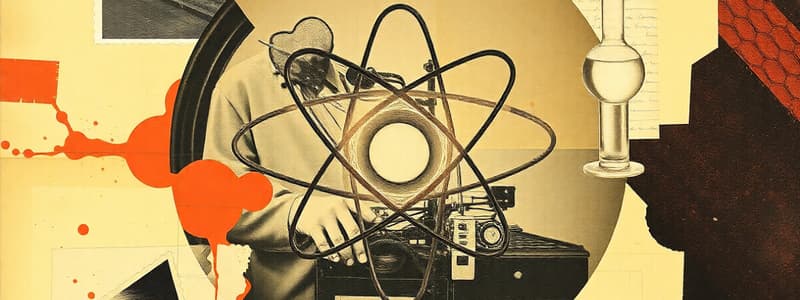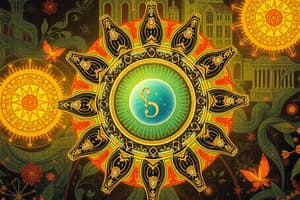Podcast
Questions and Answers
What determines the atomic number of an element?
What determines the atomic number of an element?
- Number of electrons in the atom
- Number of neutrons in the atom
- Total mass of the atom
- Number of protons in the atom (correct)
Which particles are found in the nucleus of an atom?
Which particles are found in the nucleus of an atom?
- Neutrons and photons
- Electrons and neutrons
- Protons and electrons
- Protons and neutrons (correct)
How do isotopes of an element differ from each other?
How do isotopes of an element differ from each other?
- Different charge
- Different number of protons
- Different number of neutrons (correct)
- Different number of electrons
What is the primary reason why atomic weights are not whole numbers?
What is the primary reason why atomic weights are not whole numbers?
What trend occurs in atomic radius as you move top to bottom in a group on the periodic table?
What trend occurs in atomic radius as you move top to bottom in a group on the periodic table?
Which element has 3 energy levels and 3 valence electrons?
Which element has 3 energy levels and 3 valence electrons?
Which statement correctly describes the charge of protons and electrons?
Which statement correctly describes the charge of protons and electrons?
What happens to the number of valence electrons as you move left to right across a period?
What happens to the number of valence electrons as you move left to right across a period?
What is the reason for Fluorine having a smaller atomic radius than Chlorine?
What is the reason for Fluorine having a smaller atomic radius than Chlorine?
What does the mass number of an element represent?
What does the mass number of an element represent?
Flashcards
Atomic Number
Atomic Number
The number of protons in an atom's nucleus, which determines its atomic identity.
Mass Number
Mass Number
The total number of protons and neutrons in an atom's nucleus.
Isotopes
Isotopes
Atoms of the same element that have the same number of protons but differ in the number of neutrons.
Nucleus
Nucleus
Signup and view all the flashcards
Electrons
Electrons
Signup and view all the flashcards
Valence Electrons
Valence Electrons
Signup and view all the flashcards
Atomic Radius
Atomic Radius
Signup and view all the flashcards
Shielding Electrons
Shielding Electrons
Signup and view all the flashcards
Periodic Table
Periodic Table
Signup and view all the flashcards
Periodic Law
Periodic Law
Signup and view all the flashcards
Study Notes
Atomic Structure
- Atoms are mostly empty space
- Atoms contain a small, dense, positively charged nucleus
- The nucleus contains protons and neutrons
- Electrons orbit the nucleus
- Protons have a positive charge (+1)
- Neutrons have no charge (0)
- Electrons have a negative charge (-1)
- Location: Protons and neutrons are located in the nucleus, electrons are outside the nucleus
Atomic History
- Experiments like the cathode ray tube and gold foil experiments led to the understanding of atomic structure
- Alpha particles were deflected when passing near the positive nucleus
- The gold foil experiment showed that most of the atom is empty space
Atomic Numbers and Mass Numbers
- Atomic number = number of protons in an atom
- Mass number = number of protons + number of neutrons
- Isotopes have the same number of protons but different numbers of neutrons (different mass numbers)
- The average atomic weight on the periodic table is an average of the isotopes
Periodic Table Trends
- Atomic radius increases as you go down a group (due to more energy levels)
- Atomic radius decreases as you go across a period (due to increasing nuclear charge)
- Number of valence electrons increase as you move across a period, and repeat after each group-increase
- Number of energy levels increase going down a group
- Elements in a family have similar properties due to similar valence electrons
- Elements are categorized on the periodic table based on their electron configuration.
Isotopes
- Isotopes of an element have the same number of protons and electrons (same atomic number)
- Isotopes have different numbers of neutrons
- Isotopes have different mass numbers
Studying That Suits You
Use AI to generate personalized quizzes and flashcards to suit your learning preferences.



